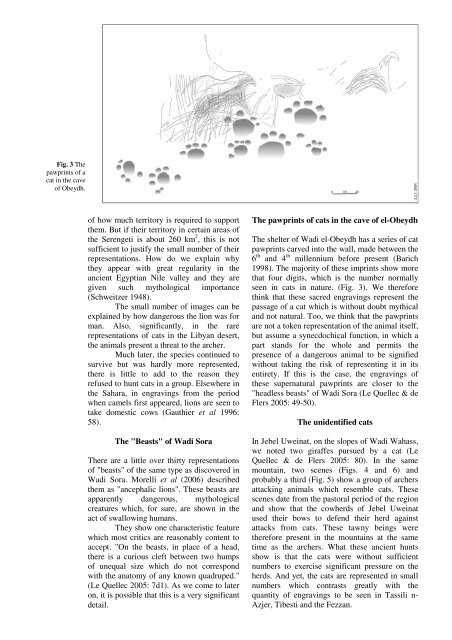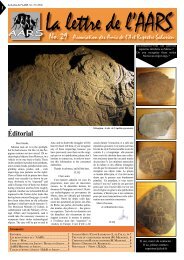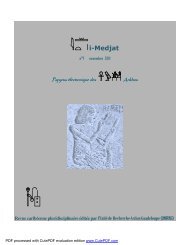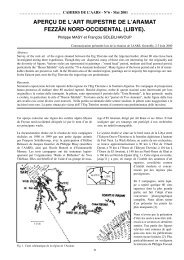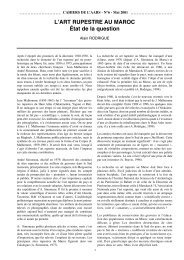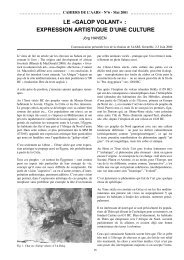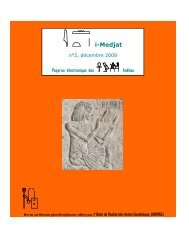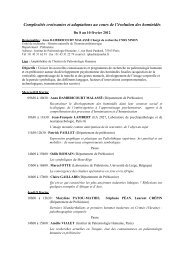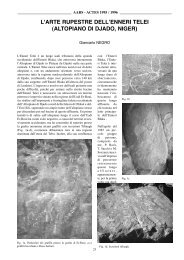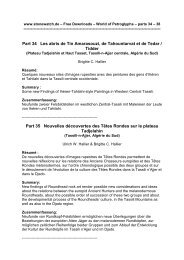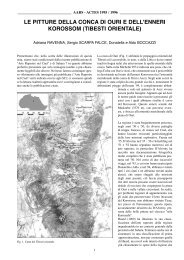From the Sahara to the Nile - Amis de l'Art rupestre saharien (AARS)
From the Sahara to the Nile - Amis de l'Art rupestre saharien (AARS)
From the Sahara to the Nile - Amis de l'Art rupestre saharien (AARS)
Create successful ePaper yourself
Turn your PDF publications into a flip-book with our unique Google optimized e-Paper software.
Fig. 3 The<br />
pawprints of a<br />
cat in <strong>the</strong> cave<br />
of Obeydh.<br />
of how much terri<strong>to</strong>ry is required <strong>to</strong> support<br />
<strong>the</strong>m. But if <strong>the</strong>ir terri<strong>to</strong>ry in certain areas of<br />
<strong>the</strong> Serengeti is about 260 km 2 , this is not<br />
sufficient <strong>to</strong> justify <strong>the</strong> small number of <strong>the</strong>ir<br />
representations. How do we explain why<br />
<strong>the</strong>y appear with great regularity in <strong>the</strong><br />
ancient Egyptian <strong>Nile</strong> valley and <strong>the</strong>y are<br />
given such mythological importance<br />
(Schweitzer 1948).<br />
The small number of images can be<br />
explained by how dangerous <strong>the</strong> lion was for<br />
man. Also, significantly, in <strong>the</strong> rare<br />
representations of cats in <strong>the</strong> Libyan <strong>de</strong>sert,<br />
<strong>the</strong> animals present a threat <strong>to</strong> <strong>the</strong> archer.<br />
Much later, <strong>the</strong> species continued <strong>to</strong><br />
survive but was hardly more represented,<br />
<strong>the</strong>re is little <strong>to</strong> add <strong>to</strong> <strong>the</strong> reason <strong>the</strong>y<br />
refused <strong>to</strong> hunt cats in a group. Elsewhere in<br />
<strong>the</strong> <strong>Sahara</strong>, in engravings from <strong>the</strong> period<br />
when camels first appeared, lions are seen <strong>to</strong><br />
take domestic cows (Gauthier et al 1996:<br />
58).<br />
The "Beasts" of Wadi Sora<br />
There are a little over thirty representations<br />
of "beasts" of <strong>the</strong> same type as discovered in<br />
Wadi Sora. Morelli et al (2006) <strong>de</strong>scribed<br />
<strong>the</strong>m as "ancephalic lions". These beasts are<br />
apparently dangerous, mythological<br />
creatures which, for sure, are shown in <strong>the</strong><br />
act of swallowing humans.<br />
They show one characteristic feature<br />
which most critics are reasonably content <strong>to</strong><br />
accept. "On <strong>the</strong> beasts, in place of a head,<br />
<strong>the</strong>re is a curious cleft between two humps<br />
of unequal size which do not correspond<br />
with <strong>the</strong> ana<strong>to</strong>my of any known quadruped."<br />
(Le Quellec 2005: 7d1). As we come <strong>to</strong> later<br />
on, it is possible that this is a very significant<br />
<strong>de</strong>tail.<br />
The pawprints of cats in <strong>the</strong> cave of el-Obeydh<br />
The shelter of Wadi el-Obeydh has a series of cat<br />
pawprints carved in<strong>to</strong> <strong>the</strong> wall, ma<strong>de</strong> between <strong>the</strong><br />
6 th and 4 th millennium before present (Barich<br />
1998). The majority of <strong>the</strong>se imprints show more<br />
that four digits, which is <strong>the</strong> number normally<br />
seen in cats in nature. (Fig. 3). We <strong>the</strong>refore<br />
think that <strong>the</strong>se sacred engravings represent <strong>the</strong><br />
passage of a cat which is without doubt mythical<br />
and not natural. Too, we think that <strong>the</strong> pawprints<br />
are not a <strong>to</strong>ken representation of <strong>the</strong> animal itself,<br />
but assume a synecdochical function, in which a<br />
part stands for <strong>the</strong> whole and permits <strong>the</strong><br />
presence of a dangerous animal <strong>to</strong> be signified<br />
without taking <strong>the</strong> risk of representing it in its<br />
entirety. If this is <strong>the</strong> case, <strong>the</strong> engravings of<br />
<strong>the</strong>se supernatural pawprints are closer <strong>to</strong> <strong>the</strong><br />
"headless beasts" of Wadi Sora (Le Quellec & <strong>de</strong><br />
Flers 2005: 49-50).<br />
The uni<strong>de</strong>ntified cats<br />
In Jebel Uweinat, on <strong>the</strong> slopes of Wadi Wahass,<br />
we noted two giraffes pursued by a cat (Le<br />
Quellec & <strong>de</strong> Flers 2005: 80). In <strong>the</strong> same<br />
mountain, two scenes (Figs. 4 and 6) and<br />
probably a third (Fig. 5) show a group of archers<br />
attacking animals which resemble cats. These<br />
scenes date from <strong>the</strong> pas<strong>to</strong>ral period of <strong>the</strong> region<br />
and show that <strong>the</strong> cowherds of Jebel Uweinat<br />
used <strong>the</strong>ir bows <strong>to</strong> <strong>de</strong>fend <strong>the</strong>ir herd against<br />
attacks from cats. These tawny beings were<br />
<strong>the</strong>refore present in <strong>the</strong> mountains at <strong>the</strong> same<br />
time as <strong>the</strong> archers. What <strong>the</strong>se ancient hunts<br />
show is that <strong>the</strong> cats were without sufficient<br />
numbers <strong>to</strong> exercise significant pressure on <strong>the</strong><br />
herds. And yet, <strong>the</strong> cats are represented in small<br />
numbers which contrasts greatly with <strong>the</strong><br />
quantity of engravings <strong>to</strong> be seen in Tassili n-<br />
Azjer, Tibesti and <strong>the</strong> Fezzan.


